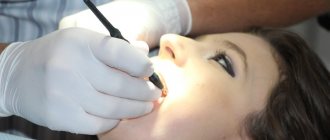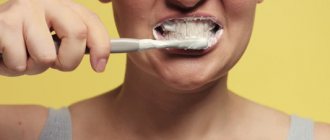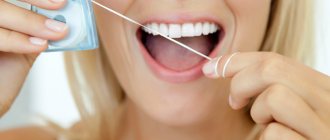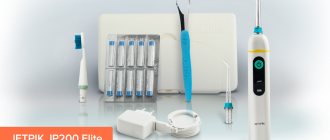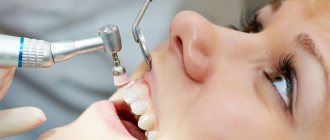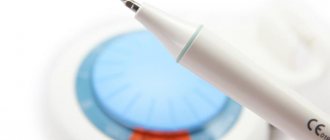Oral hygiene is an important component of the health of the whole body. Many people neglect brushing their teeth twice a day, carrying out this procedure only in the morning. However, professional dentists say: in order to prevent caries and protect the oral cavity from the growth of harmful bacteria, it is necessary not only to brush your teeth twice a day, but also to do it correctly. Let's Let's look at a few basic points in the process of brushing your teeth that will help you keep your mouth clean and keep your teeth and gums healthy.
How many times a day should you brush your teeth?
As we noted earlier, you need to brush your teeth at least twice a day - in the morning and before bed. Professional dentists recommend paying more attention to the evening procedure.
Brushing your teeth before bed is necessary to prevent tooth decay: the food you eat during the day settles on your teeth in the form of plaque and at night promotes the proliferation of harmful bacteria. This can lead to gum inflammation and tooth decay.
The morning routine of brushing your teeth can be done before or after breakfast. However, if you have eaten juice or fruit, you should wait an hour before brushing your teeth. The acid contained in these products softens the enamel and you risk “cleaning out” useful minerals from it.
How often should you visit a dentist for professional oral hygiene?
In order to notice the beginning of pathological processes in time and take action, dentists recommend visiting them once every 6 months, and if you are prone to rapid plaque formation and the formation of tartar and in the presence of orthodontic structures - once every 3-4 months.
During the process of professional hygienic cleaning, the doctor will examine the teeth and mucous membranes, remove residual plaque, polish the teeth, and, if necessary, apply a protective layer of fluoride varnish [4].
List of sources
- Leontiev V.K., Pakhomov G.N. / Prevention of dental diseases // V.K. Leontiev, G.N. Pakhomov. — M: KMK-INVEST, 2006 // URL: https://e-stomatology.ru/pressa/literatura/profilaktic/ (date of access: 08/06/2020).
- Clinical recommendations (treatment protocols) for the diagnosis of dental caries, approved by Resolution No. 15 of the Council of the Association of Public Associations “Dental Association of Russia” dated September 30, 2014. Updated August 2, 2022 // URL: https://www.e-stomatology.ru/director/protokols/protokols_30-09-2014/4_karies_8aug2018.doc (access date: 08/06/2020).
- Dental floss, Directory of dentistry // URL: https://rsdent.ru/zubnaya-nit (access date: 08/06/2020).
- Teeth cleaning, Directory of dentistry // URL: https://rsdent.ru/chistka-zubov (access date: 08/06/2020).
Toothbrush hardness
The stiffness of the brush is determined by the diameter of the fiber - the larger it is, the stiffer the brush will be. Nowadays, manufacturers often indicate the degree of hardness on packaging: very soft (ultra soft, extra soft), soft (soft), medium (medium), hard and very hard (hard).
Very soft brushes are suitable for children under 5 years old and people with sensitive teeth. Soft brushes - for children from 5 to 12 years old, as well as for severe pain in the teeth and gums. Medium hardness brushes are suitable for children over 12 years old and adults.
Hard and very hard brushes are not recommended for use without consulting a doctor. Such brushes can injure the gums and cause abrasion of the hard tissues of the teeth.
Stages of the procedure
Professional sanitation of the oral cavity is carried out in stages.
Stage 1: Comprehensive inspection
It is performed using modern instruments to identify deposits and assess the condition of tissues.
Stage 2: removal of soft and hard formations
To obtain high results, two methods are combined: ultrasonic cleaning and Air Flow. The first option destroys the structure of tartar, the second removes plaque and remaining stone.
Stage 3: Polishing
The enamel is polished using special brushes and paste. The surface is smooth and shiny.
Stage 4: fluoridation
To protect bone tissue, a gel or varnish containing a high concentration of fluoride is used.
How do children brush their teeth?
Ultrasonic cleaning and Air Flow are not prescribed for children under 14 years of age. Professional sanitation of the oral cavity is performed using special brushes and paste. After dental treatment, the surface is coated with fluoride-containing gel to strengthen the enamel.
Abrasiveness of toothpaste
Abrasiveness is considered an indicator of the ability of toothpaste to disrupt the structure of enamel and dentin due to abrasion.
The abrasive substances in the paste are responsible for this indicator: silicon compounds, silicon dioxide, hydrated silicon dioxide, or calcium carbonate and calcium phosphate compounds.
A high degree of abrasiveness, although it contributes to high cleaning power, but at the same time causes more damage to tooth enamel. There are 4 levels of toothpaste abrasiveness:
- Low level of abrasiveness - RDA 0-70. Recommended for children and adolescents up to 12-14 years old and adults with hypersensitivity of teeth and gums. For children under 6-7 years of age, an abrasiveness of up to 40 is more suitable. Such pastes have minimal impact on tooth enamel and dentin.
- The average level of abrasiveness is RDA 70-100. This level of abrasiveness is suitable for children from 14 years of age for daily brushing of teeth. Such pastes help maintain the natural color of teeth after professional cleaning and whitening. If you have increased sensitivity of your teeth and gums, it is better to use pastes with low abrasiveness.
- High level of abrasiveness - RDA 100-150. Recommended for people over 14 years old. If you often drink tea, coffee drinks, or tobacco, then periodic use of highly abrasive paste is also suitable for you. When used occasionally and alternating with a paste of medium abrasiveness, it cleans well and does not seriously injure the enamel.
- Very high level of abrasiveness - RDA above 150. Dentists do not recommend using such pastes frequently, as they can cause serious damage to the enamel. Only a specialist can prescribe high abrasive pastes. You must brush your teeth strictly following your doctor's recommendations.
Therapeutic and prophylactic pastes
These pastes contain substances that have an antibacterial effect. Their effect is to reduce inflammation and prevent the development of caries. Such pastes should be purchased on the recommendation of a specialist in pharmacies.
Such pastes are divided into:
- Contains extracts of medicinal herbs and essential oils that help relieve inflammation and accelerate tissue regeneration processes. The essential oils in the composition help eliminate bad breath.
- Containing minerals and salts, which helps strengthen tooth enamel, accelerate tissue healing and reduce plaque formation.
Alternative remedies
To more effectively clean the mouth, in addition to a toothbrush, you should use alternative cleaning products:
- Dental floss. Allows you to remove food debris in the space between the teeth, where a regular brush is not so effective. You need to use dental floss carefully so as not to damage the soft tissue. Under no circumstances should you try to replace dental floss with regular threads - they have a completely different structure and do not have an antiseptic coating.
- Interdental brushes: These brushes are best suited for large, irregular or concave tooth surfaces. To achieve the best result, the diameter of the brush should be larger than the space between the teeth.
- Toothpicks. Small wooden sticks that allow you to get rid of food debris between your teeth. You should also be careful with toothpicks so as not to damage soft tissue.
- Irrigators. A device for cleaning the space between teeth and at the junction of tooth and gum. The irrigator nozzle delivers a stream of water under a pressure of 0.7 - 4.8 bar - this allows you to wash away food debris and remove soft plaque from the surface of the teeth, gums, and oral mucosa.
How else to maintain dental health: floss or irrigator?
A modest set of toothbrush and toothpaste is the bare minimum, which does not guarantee reliable protection against caries. Therefore, it is advisable to maintain dental health not only with its help.
Caries most often begins its destructive activity in hard-to-reach places between the teeth, where the brush cannot penetrate.
- Floss and irrigator are two effective devices that cope with high-quality cleaning of interdental spaces.
The irrigator is more suitable for wearers of braces and dentures, and is indispensable for certain gum diseases. And floss is inexpensive and simple; be sure to use it while brushing your teeth. Believe me, you will immediately feel how much cleaner your teeth have become.
Proper Teeth Brushing Technique
High-quality and safe teeth cleaning includes 4 main processes:
- cleaning the outside of the teeth with sweeping movements from top to bottom;
- brushing the inside of the teeth with vertical movements using the tip of the brush;
- Clean the chewing surface of your teeth using back and forth movements;
- massage your gums by closing your jaw and making circular movements along the surface of your teeth.
After completing the main procedures, use dental floss or another means to clean the space between the teeth.
Bleeding gums after professional cleaning
Sometimes you can come across complaints from patients that after cleaning their teeth from tartar, bleeding gums appeared. The reason is not the cleaning procedure itself, but the lack of qualifications of doctors. Therefore, you need to trust your health to professionals: find a good clinic where competent dentists will do everything right and avoid complications.
The financial costs of professional teeth cleaning are much less than the treatment of caries, which can be hidden under plaque, and its complications; Regular teeth cleaning by a specialist will help maintain your health, which means saving time and money.
Which brush to use
As we found out earlier, you should choose a toothbrush based on the sensitivity of your teeth. Dentists recommend using brushes with low or medium hardness.
Stiffer brushes can only be used as prescribed by a specialist and all recommendations are followed. Otherwise, you may damage the surface of your teeth and soft tissues.
Electric toothbrushes are not as effective as they might seem. They do not sufficiently clean the surface of the tooth and drive food debris into the space between the tooth and gum. It is better to opt for a regular brush with a hardness that suits you.
Tartar can only be removed in a clinic
Gradually, the plaque hardens, mineralizes and turns into tartar. In addition to the fact that teeth acquire an unpleasant yellowish tint near the roots, the stone contributes to the growth of soft plaque, potentially increasing the risk of gum pocket inflammation and periodontal disease.
Tartar removal: before and after
While soft plaque is difficult to remove at home, tartar is impossible. Even abrasive pastes, for example, based on salt or coal (these are sold in lines of “natural” cosmetic products), will not affect it in any way.
What paste to use
According to GOST, toothpastes are divided into hygienic and therapeutic and prophylactic. Hygienic pastes are designed for mechanical cleansing, removing food debris and plaque from enamel. Therapeutic and prophylactic products are intended for the prevention of oral diseases. Such pastes have an antiseptic and anti-inflammatory effect.
Rospotrebnadzor identifies 4 types of toothpastes:
- with fluoride content - reduce the risk of developing caries and demineralization of enamel;
- with triclosan - have an anti-inflammatory effect in gum diseases;
- having a whitening effect - help in the fight against dark plaque;
- with an anesthetic effect - reduces the increased sensitivity of teeth to sour, hot and cold.
Recommendations from dentists: a modern approach to caries prevention
Bacterial film, or plaque, forms on the surface of teeth and mucous membranes almost constantly. These are the remains of food and drinks, as well as the results of the vital activity of the normal microflora of the oral cavity. Such accumulations are proteinaceous in nature and quite densely cover the surface of the tooth enamel. They can be felt as a slightly rough sticky coating, and externally they can look like a thin, translucent film with a yellowish tint.
If dental plaque is not removed in a timely manner, then after 10–12 hours it hardens as the mineralization process begins. tartar is formed . To effectively remove existing soft plaque and prevent the development of hard dental plaque, you need to maintain an interval between brushings (10–12 hours) and carry out the procedure for at least 2 minutes.
Physiologically, the oral cavity is adapted to self-cleaning due to the activity of saliva, the work of muscles, tongue, lips during talking, swallowing, chewing, breathing, etc. However, unfavorable factors are an excess of carbohydrates in food, chewing too quickly, preference for soft foods, use of antibiotics without doctor's prescriptions, diseases of the dental system - disrupt self-cleaning processes and increase the risk of caries.
This once again emphasizes the importance of preventing dental diseases and developing hygienic skills for caring for teeth and the oral cavity. Leontyev V.K., academician of the Russian Academy of Medical Sciences, professor[1]
There is a fairly common misconception that frequent brushing of teeth or the use of mouth rinses will save you from plaque formation. It must be remembered that an incorrectly selected toothbrush, as well as the use of specialized toothpaste (especially highly abrasive or with active additives) not according to the instructions can cause microtrauma to the tooth enamel. Invisible cracks form on it, in which bacteria accumulate, and it is difficult to remove them from there. This is how the process of caries formation starts. Therefore, brushing your teeth too often is not recommended.
The second common mistake is neglecting the recommendation about the need to brush your teeth twice. If oral hygiene is carried out once a day, this will not be enough to remove plaque and prevent the formation of tartar.
How long to brush your teeth
To achieve the best results when brushing your teeth, you must not only adhere to the correct technique, but also brush your teeth for a certain amount of time. Professional dentists say that the most optimal time for brushing the oral cavity is 2 minutes - 30 seconds for each half of the upper and lower jaw.
By following all these recommendations, you can easily achieve oral health and visit the dentist less often, only for prevention and professional cleaning.
In adults
Brushing your teeth in the morning removes plaque accumulated during the night, gives your teeth a clean look and ensures fresh breath. However, you should not brush your teeth immediately after breakfast, since after eating, the enamel is most sensitive and susceptible to destruction. The duration of brushing your teeth should be 2-3 minutes, on average 1 minute for each jaw. Unfortunately, very often teeth are brushed in a hurry, without devoting the necessary time to oral hygiene. Such care can cause plaque formation and gum inflammation. Bacteria accumulated under plaque destroy tooth enamel and cause inflammation in the oral cavity. Proper hygiene prevents the development of caries and gum disease.

